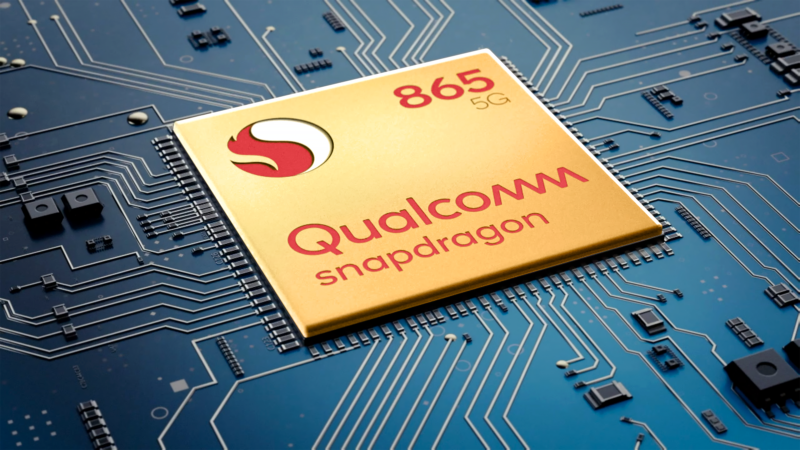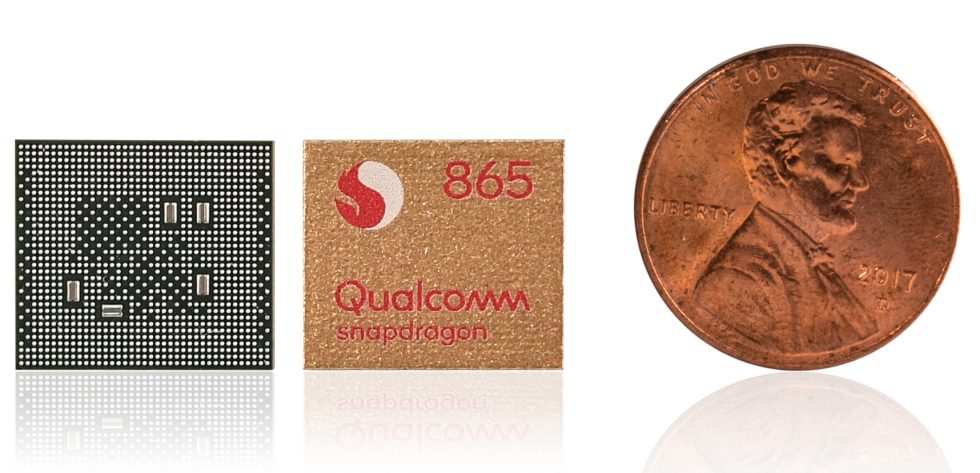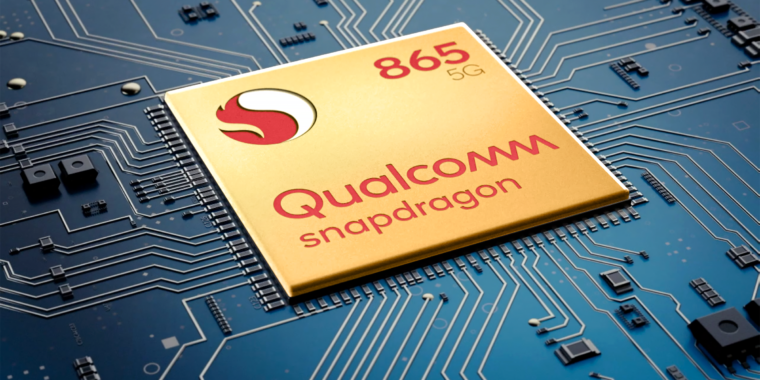
Enlarge / The Snapdragon 865.
Today, Qualcomm detailed its new flagship SoC for 2020: the Snapdragon 865. This is going to be the chip that ships in every single high-end Android phone that comes out in 2020, and there's a lot to go over.
First up: we're getting the usual modest speed increases that Qualcomm delivers every year. Qualcomm says the CPU and GPU are 25 percent faster compared to this year's Snapdragon 855. Like last year, this is an eight core, 7nm chip, but as AnandTech reports, now it's being manufactured on TSMC-improved 7nm "N7P" node, the same manufacturing process used by Apple's A13 SoC.
This year, the bigger CPU cores have been upgraded from Qualcomm's Kryo 485 cores in the 855. They have also been based on ARM's Cortex A76 design, to the new "Kryo 585 CPU," which uses ARM Cortex A77 cores. The frequencies are unchanged from last year: the single "Prime" A77 core is at 2.84GHz, and three other A77 cores are at 2.42 GHz. Four Cortex A55s make up the smaller cores for background processing and other lower-power tasks and are clocked at 1.8GHz.

Enlarge / The Snapdragon 865 block diagram.
Qualcomm
Qualcomm has made a heap of improvements to the camera performance to the 865's new Spectra 480 image signal processor (ISP). The camera co-processor now has a max processing bandwidth of 2 gigapixels per second, allowing for cameras up to 200MP, and video capture modes of 8K at 30fps or 4K at 120fps. High speed is still capped at 960fps at 720P, but you'll be able to record that speed indefinitely now, instead of only in short busts. Overall, Qualcomm is promising 40 percent better performance out of the camera pipeline.
Qualcomm has been putting more and more emphasis on the Hexagon DSP, which it now calls a "Tensor Accelerator" designed for AI compute tasks written with Google's Tensorflow library. Thanks to this new co-processor, Qualcomm says its "AI Engine" can do 4 times as many operations per second as the last year's model.
Given that Qualcomm and Android are the "Wintel" of the mobile world, the Snapdragon 865 also brings a few Android-centric benefits. David Ruddock of Android Police reports that Qualcomm will start providing Snapdragon 865 graphics driver updates through the Play Store, allowing users to update their graphics drivers just as they would an app.
Google has been pushing SoC vendors to do this since Android 8.0 Oreo, which first enabled updatable graphics drivers, but as always, the wider Android ecosystem has shown indifference to keeping consumer software up-to-date. We'll see. Ruddock suspects this year the graphics driver update will be a Project Mainline module, which was a new high-permission filetype introduced in Android 10, enabling for modular system components.
Qualcomm also announced that the 865 will be one of the first chips to support Google's new digital driver's license scheme, aka the Android "IdentityCredential APIs" coming in "Android R" (the 2020 version of Android). The idea is that instead of lugging around a dumb plastic card, you could carry state- and federally-recognized ID in your smartphone as just another app. We don't have a ton of detail on this yet, but Android code commits found by XDA Developers show the special APIs provide a secure storage of a digitally-signed identity in accordance with the ISO 18013-5 standard for a "mobile driving licence application." Before you run in to the comments to type "What if my battery dies?"—there's a mode that would allow your digital ID to be shown when the battery is too low to boot into the full Android OS. There is even work being done to allow for transferring this information to a police officer without having to unlock your entire phone, so the cops can't start digging through your phone for evidence.
While Google and Qualcomm seem hard at work on the technical aspects of a digital driver's licence, this is also a legal issue, and you would need to friendly neighborhood governments to be on-board with a change like this.
Get ready to pay for mandatory 5G
This is Qualcomm so of course we have to talk about 5G. The bad news is that 5G is still not integrated this year in the Snapdragon 865, and will require the separate Snapdragon X55 chip that was announced in February. The even worse news is that Qualcomm is really leveraging its monopoly power this year, and forcing all Snapdragon 865 phones to also ship the with the separate 5G X55 modem. So while most people probably don't have access to a 5G network yet, Qualcomm is going to force all 2020 flagships to have 5G modems, resulting in bigger, more expensive devices with less battery life.

Enlarge / The Snapdragon 865 with a penny for scale.
Qualcomm
There are two kinds of "5G" out there: mmWave 5G and Sub-6GHz 5G. When people talk about the generational speed increases from 5G, they're talking about mmWave. Early real-world mmWave networks can already hit 760 Mbps, but that comes at the cost of an extremely limited range for each tower, tons of penetration issues, and being an all-around nightmare to work with, thanks to mmWave living in the 24GHz-and-above spectrum.
MmWave is favored by US carriers, but the rest of the world is more focused on the other kind of 5G: sub-6GHz 5G. Sub-6GHz doesn't offer the generational speed improvements of mmWave—T-Mobile recently said to expect only a 20 percent speed increase, which, using T-Mobile's average download speeds as measured by OpenSignal, would bump you from 22 Mbps to 26 Mbps. It does offer a much more sane rollout plan, though, with range and penetration more comparable to the range of a 4G LTE tower.
Qualcomm is requiring any Snapdragon 865 customers to also include a Snapdragon X55 Modem in their phone designs, and at the bare minimum, Qualcomm is allowing vendors to do, that would give you access to sub-6GHz 5G, but not mmWave 5G. The penetration of mmWave is so poor that your hand can block the signal, so the industry solution is to place multiple antennas around the phone body, increasing the power usage, complexity, cost, and size of the phone. This mmWave step is still optional, so get ready to see a bunch of "5G" phones that support sub-6GHz but not mmWave.
As usual, the Snapdragon 865 will be in every single high-end Android phone released next year, the first of which should be the Samsung Galaxy S11, due out sometime in February.
